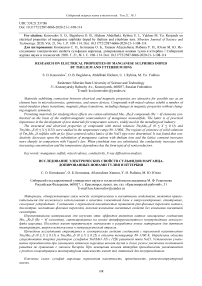Research on electrical properties of manganese sulphides doped by thulium and ytterbium ions
Автор: Konovalov S. O., Begisheva O. B., Hichem Abdelbaki, Rybina U. I., Yukhno M. Yu.
Журнал: Siberian Aerospace Journal @vestnik-sibsau-en
Рубрика: Technological processes and material science
Статья в выпуске: 1 vol.21, 2020 года.
Бесплатный доступ
Materials exhibiting connection between electrical and magnetic properties are attractive for possible use as an element base in microelectronics, spintronics, and sensor devices. Compounds with mixed valence exhibit a number of metal-insulator phase transitions, magnetic phase transitions, including changes in magnetic properties without changing magnetic symmetry. Promising materials for studying these effects are cation-substituted Mn1−xRexS compounds (Re = 4f elements) synthesized on the basis of the antiferromagnetic semiconductor of manganese monosulfide. The latter is of practical importance in the development of new materials for temperature sensors, widely used in the metallurgical industry. The structural and electrical properties of compounds with mixed valences TmXMn1-ХS (0 ≤ X ≤ 0.15) and TmXMn1-ХS (0 ≤ X ≤ 0.25) were studied in the temperature range 80–1100K. The regions of existence of solid solutions of TmXMn1-XS sulfides with an fcc (face-centered cubic) lattice of the NaCl type were determined. It was found that conductivity decreases upon the substitution of manganese cations with thulium ions and the lattice constant increases more sharply in comparison with Vegard’s law. When ytterbium ions are substituted, the conductivity increases with increasing concentration and the temperature dependence has the form typical of semiconductors.
Manganese sulfide, mixed valence, conductivity, X-ray diffraction analysis.
Короткий адрес: https://sciup.org/148321726
IDR: 148321726 | УДК: 539.21:537.86 | DOI: 10.31772/2587-6066-2020-21-1-108-114
Текст научной статьи Research on electrical properties of manganese sulphides doped by thulium and ytterbium ions
Introduction. Compounds containing rare-earth chemical elements with mixed valence such as Sm, Yb, Ce, Eu, Tm have a number of unique properties. Phase transitions of purely electronic nature and associated with change in the filling of 4f electronic levels [1] often occur in them when external conditions (temperature, pressure, composition) change. At the same time the magnetic properties also change [2–4] (localized magnetic moments disappear), i. e. the transitions are of the “magnetic – nonmagnetic” state type [5]. Change in the type of conductivity from semiconductor to metal type and a significant magnitude of magnetoresistance (of the order of 100 %) in the paramagnetic region at room temperatures and above [6–11] is observed in manganese sulfides substituted by samarium [6] and gadolinium [7] ions.
Thulium sulfide has a cubic crystalline structure with a lattice parameter of 5.412 Å. This compound is characterized by a metallic type of conductivity at T > 100 K with electron concentration of about 1022 cm –3 and resistivity of about 10–6 Ohm / cm at room temperature [2]. Thulium whose electronic configuration of the 4f – shell is unstable and close to a filled one, can enter the compounds with other elements, be in the state of Tm2+ 4f13 term 2F 7 / 2 and Tm3 + 4f12 term 3H 6 . In TmS a thulium ion is in the trivalent state with a 4f level filling of n f = 0.65 and the energy difference between the divalent and triva-lent states E2+ – E3+ = 0.3 eV [12]. The proximity of the energies of thulium aliovalent states leads to the fact that TmS exhibits a condo effect in which band electrons group around thulium ions screening its magnetic moment [13]. Under the action of pressure “quasilocalized” states expand and pass into the conduction band, which will manifest itself in the form of transition to the usual metallic state. This is confirmed by the baric dependence of thulium thermopower, which decreases under pressure to 20 GPa, and ceases to change at higher pressures [14]. Pressure leads to changing magnetic characteristics and magnetic structure [15–18]
Ytterbium sulfide at normal pressure is a semiconductor with a direct gap in the spectrum of electronic excitations ~ 1.3 eV and an indirect gap ~ 1.0 eV between the fully occupied f -state and free sd -band states [19], which are 4 eV higher in energy than the 3 p -valence band of sulfur ions. Under pressure the gap monotonically decreases dEg / d p = -6 ± 1 eV / kbar [20], at 8 GPa the zones overlap and a metallic state arises [21]. At 10 GPa quantum resonance, that is, a superposition of f 13 and f 14 states and change in valence from 2 to 4 is observed. The density of current carriers per an ytterbium ion is 0.4 [22]
Materials and methods of research . The synthesis of Mn1-XReXS samples is described in detail in [8]. Solid solutions Mn1-XTmXS and Mn1-XYbXS were obtained by solid-phase synthesis, degrees of substitution 0.05; 0.10; 0.15 and 0.05; 0.10; 0.15; 0.2; 0.25 respectively.
X-ray diffraction analysis of Mn1-ХTmХS (X = = 0.05; 0.15) and Mn1-ХYbХS (X = 0.1; 0.2) sulfides was carried out on a DRON-3 installation in CuKα-radiation at temperature of 300 K after they were obtained and their transport properties were measured. X-ray diffraction patterns obtained after the measurements indicate that all the substances studied have a face-centered cubic (fcc) structure of the NaCl type typical of manganese monosulfide.
The conductivity was measured in the temperature range 80–1100 K using the four-probe method. The four-probe method for measuring electrical resistivity is the most common. The method is very convenient since there is no need to create ohmic contacts; it is possible to measure the resistivity of bulk samples of the most diverse shapes and sizes, as well as the resistivity of layers of semiconductor structures, for example, during ion implantation. In this case, one condition must be fulfilled as far as the shape is concerned, that is, the presence of a flat surface whose linear dimensions exceed the linear dimensions of the probe system (the distance between them).
Four metal probes with a small contact area (fig. 1) the distances between which are s 1 , s 2 , s 3 , are placed on the flat surface of the sample along a straight line. Electric current I 14 is passed through two external probes 1 and 4, and the potential difference U 23 is measured on two internal probes 2 and 3.
Results and discussion . X-ray diffraction patterns of the synthesized sulfides were obtained (fig. 2, 3). X-ray diffraction patterns obtained after measurements indicate that all the substances studied have a stable crystalline state up to temperatures of the order of 1100K. X-ray diffraction analysis showed that the synthesized compounds are single-phase and have a face-centered cubic (fcc) structure of the NaCl type, typical of manganese monosulfide. With increase in the degree of cationic substitution (X), the unit cell parameter a increases linearly, which indicates the formation of Mn 1-X Tm X S and Mn 1-X Yb X S solid solutions (fig. 2, 3). Increase in the lattice constant, compared with linear growth according to Vegard’s law, is possibly associated with the localization of electrons at the interface of manganese ions with substituted ones and with weak hybridization of 4f-3d orbitals, which is described by an exponential dependence on distance.
The temperature dependence on conductivity was measured for the synthesized samples Mn 1-Х Tm Х S (0.01 ≤ X ≤ 0.15) and Mn 1-Х Yb Х S (0.05 ≤ Х ≤ 0.25) (fig. 4). The behavior of the lnσ (103 / T) dependences is characteristic of substances with semiconductor conductivity. Fig. 4, a shows the electrical conductivity of Tm X Mn 1-X S solid solutions. A sample with a thulium substitution degree of X = 0.05 has a conductivity plateau from 310 to 380 K. For X = 0.1 there is an anomaly in the conductivity behavior from 330 to 360 K. For X = 0.15 there is an anomaly in the conductivity behavior from 650 K to 690 K. All of the studied samples with thulium are characterized by a high resistance state even at room temperature in comparison with the electrical resistance observed in manganese monosulfide [8]. Fig. 4, b shows the electrical conductivity of Tm X Yb 1-X S solid solutions. When the temperature increases the conductivity grows significantly faster in the case of ytterbium than in the case of thulium.
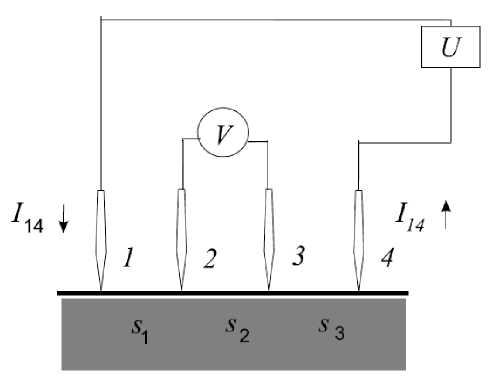
Fig. 1. A schematic diagram of measurements using the four-probe method
Рис. 1. Принципиальная схема измерений четырёхзондовым методом
I, Intensity (a.u.)
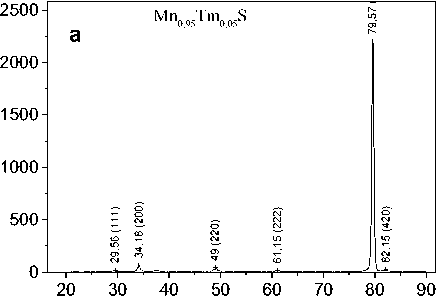

20, degree
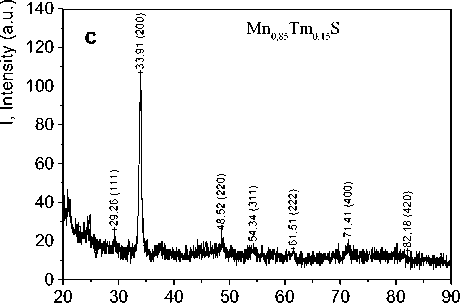
20, degree
Fig. 2. X- ray diffraction patterns of Mn 1-x Tm x S: а – X = 0.05; b – X= 0.1; с – X= 0.15
Рис. 2. Рентгенограммы Mn1-xTmxS:
а – X = 0,05; b – X = 0,1; с – X = 0,15
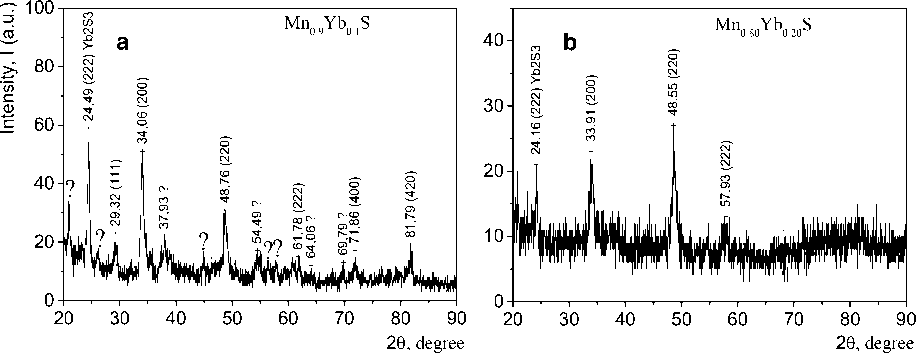
Fig. 3. X- ray diffraction patterns of Mn 1-x Yb x S: а – X= 0.1; b – X= 0.2
Рис. 3. Рентгенограммы Mn1-xYbxS: a – X= 0,1; b – X= 0,2
-5
-10
-15
-20
-25
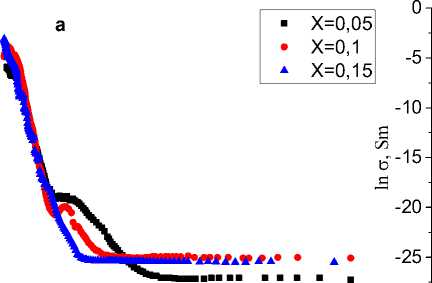
b
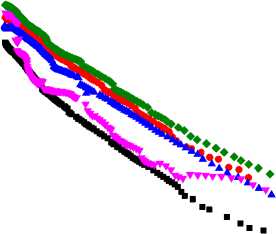
X=0,05 X=0,1 X=0,15 X=0,2 X=0,25

-
-30 -30
103/T, K-1 10 3 /T, K -1
Fig. 4. Temperature dependence on conductivity: a – Mn 1-Х Tm Х S (0.05 ≤ Х ≤ 0.15); b – Mn 1-Х Yb Х S (0.05 ≤ Х ≤ 0.25)
Рис. 4. Зависимость проводимости от температуры: a – Mn 1-Х Tm Х S (0,05 ≤ Х ≤ 0,15); b – Mn 1-Х Yb Х S (0,05 ≤ Х ≤ 0,25)
The dependences of the conductivity on the substitution concentration of thulium and ytterbium ions at room temperature are shown in fig. 5. With increase in the degree of samples doping with thulium the conductivity decreases (fig. 5, a ), and when doping with ytterbium a similar conductivity behavior occurs, but there is a section in the concentration range from X = 0.1 to X = 0.2 in which, on the contrary, growth is observed. In general, there is a nontrivial picture that is different from the behavior of impurity semiconductors, in which substitution with an alloying element increases the concentration of charge carriers and, as a result, the conductivity.
This behavior can be explained by the fact that an ytterbium ion is trivalent and, when a divalent manganese ion is substituted in a solid solution, both electrons and holes are formed by non-stoichiometry of the obtained samples. With increase in the substitution concentration, electrons and holes accumulate at intercrystalline boundaries and form a carrier-depleted layer similar to the p-n junction. Substitution with ytterbium ions leads to the formation of holes in the cationic subsystem; as a result, the conductivity decreases sharply compared to manganese sulfide. As the concentration of hole current carriers increases, the conductivity increases (fig. 5, b ).
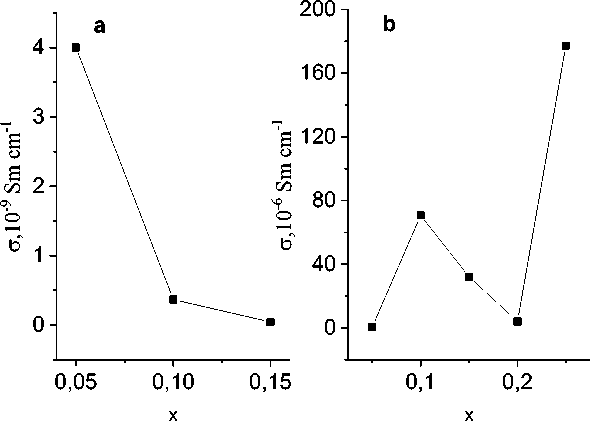
Fig. 5. Dependence of conductivity on the temperature of samples Mn 1-Х Yb Х S (0.05 ≤ Х ≤ 0.25)
Рис. 5. Зависимость проводимости от температуры образцов Mn 1-Х Yb Х S (0,05 ≤ Х ≤ 0,25)
Conclusion. X-ray diffraction analysis of solid solutions of manganese sulfides substituted by rare-earth ions of thulium and ytterbium was carried out. It was found that the synthesized compounds are single-phase ones and have a face-centered cubic (fcc) structure. There is increase in the unit cell when substituted by thulium and ytterbium.
Decrease in the conductivity upon substitution with thulium and increase in the conductivity of solid solutions upon substitution with ytterbium were found. The temperature dependence of substituted sulfides has a semiconductor form. The concentration dependence of the conductivity for Mn 1-X Tm X S is explained by the formation of a space charge at the boundaries of intercrystalline grains.
Acknowledgments. The research was financially supported by the RFPI No. 18-32-00079 mol_а and a grant from Siberian State University of Science and Technology.
Список литературы Research on electrical properties of manganese sulphides doped by thulium and ytterbium ions
- Eerenstein W., Mathur N. D., Scott J. F. Dielectric and Magnetic Properties of Nano-Structure BiFeO3 Doped with Different Concentrations of Co Ions Prepared by Sol-Gel Method. Multiferroic and Magnetoelectric Materials. Nature Journal. 2006, Vol. 442, P. 759–765.
- Golubkov A. V., Goncharova E. V., Zhuze V. P., Loginov G. M., Sergeeva V. M., Smirnov I.A. Fizicheskie svoystva khal'kogenidov redkozemel'nykh elementov [Physical properties of chalcogenides of rare earth elements.]. Leningrad, Nauka Publ., 1973, 304 p.
- Aplesnin S. S., Sitnikov M. N. Magnetotransport effects in paramagnetic GDXMN1- XS. JETP letters. 2014, Vol. 100, Iss. 1-2, P. 104–110.
- Aplesnin S. S., Petrakovskii G. A., Ryabinkina L. I., Abramova G. M., Kiselev N. I., Romanova O. B. Influence of magnetic ordering on the resistivity anisotropy of α-MNS single crystal. Solid State Communications. 2004, Vol. 129, Iss. 3, P. 195–197.
- Aplesnin S. S. Spin liquid and quantum effect in antiferromagnets. Palmarium Academic Publ., 2012, 140 p.
- Aplesnin S. S., Romanova О. B., Gorev M. V., Velikanov D. A., Gamzatov A. G., Aliev A. M. Magnetic and thermophysical properties of GdxMn1–xS solid solutions. J. Phys.: Cond. Matt. 2013, Vol. 25, P. 025802.
- Aplesnin S. S., Khar’kov A. M., Eremin E. V., Romanova O. B., Balaev D. A., Sokolov V. V., Pichugin A. Yu. Nonuniform Magnetic States and Electrical Properties of Solid Solutions. IEEE Transactions on magnetics. 2011, Vol. 47, P. 4413–4416.
- Ryabinkina L. I., Romanova O. B., Aplesnin S. S. Sulfide compounds MeXMn1-XS(Me = Cr, Fe, V, Co): technology, transport properties, and magnetic ordering. Bulletin of the Russian Academy of Science: Physics. 2008, Vol. 72, Iss. 8, P. 1050–1052.
- Ryabinkina L. I., Petrakovskii G. A., Loseva G. V., Aplesnin S. S. Metal-insulator transition and magnetic properties in disordered systems of solid solutions MEXMN1-XS. Journal of Magnetism and Magnetic Materials. 1995, Vol. 140–144, Iss. 1, P. 147–148.
- Aplesnin S. S., Ryabinkina L. I., Abramova G. M., Romanova O. B., Kiselev N. I., Bovina A. F. Spindependent transport in α-MnS single crystals. Physics of the Solid State. 2004, Vol. 46, Iss. 11, P. 2067–2072.
- Aplesnin S. S, Romanova O. B., Khar'kov A. M., Balaev D. A., Gorev M. V., Vorotinov A. I., Sokolov V. V., Pichugin A. Yu. Metal-semiconductors transition in SmXMn1-XS solid solutions. Physica Status Solidi (B): Basic Solid State Physics. 2012, Vol. 249, Iss. 4, P. 812–817.
- Strange P., Svane A., Temmerman W. M., Szotek Z., Winter H. Understanding the valence of rare earths from first-principles theory. Letters to nature. 1999, Vol. 399, Iss. 6738, P. 756–758.
- Derr J., Kneel G., Sake B., M´easson M.-A., Flouquet J. J. Valence and magnetic ordering in intermediate valence compounds : TmSe versus SmB6. J. Phys.: Condens. Matter. 2006, Vol. 18, P. 2089–2106.
- Abdusalyamova M. N., Alekseev P. A., Klement'ev E. S., Nefedova E. V., Nizhankovskiy V. I. [Change of the tulium valence in TmSb 1 – xTe x compounds]. Fizika Tverdogo Tela. 1994, T. 36, Vol. 1, P. 145–151 (In Russ.).
- Aplesnin S. S. A study of anisotropic Heisenberg antiferromagnet with S=1/2 on a square lattice by MonteCarlo method. Physica Status Solidi (B): Basic Solid State Physics. 1998, Vol. 207, Iss. 2, P. 491–498.
- Aplesnin S. S. Dimerization of antiferromagnetic chain with four-spin interactions. Physics of the Solid State. 1996, Vol. 38, Iss. 6, P. 1031–1036.
- Aplesnin S. S. Nonadiabatic interaction of acoustic phonons with spins S = 1/2 in the two-dimentional Heisenberg model. Journal of Experimental and Theoretical Physics. 2003, Vol. 97, Iss. 5, P. 969–977.
- Aplesnin S. S. Quantum Monte-Carlo analysis of the 2d Heisenberg antiferromagnet with S = 1/2: the influence of exchange anisotropy. Journal of Physics: Condensed Matter. 1998, Vol. 10, Iss. 44, P. 10061–10065.
- Syassen K., Winzen H., Zimmer H. G., Tups H., J. M. Leger. Optical response of YbS and YbO at high pressures and the pressure-volume relation of YbS. Phys. Rev. 1985, B. 32, P. 8246.
- Aplesnin S. S., Khar’kov A. M., Romanova O. B., Yanushkevich K. I., Galyas A. I., Sokolov V. V. Magnetic and electric properties of YbxMn1 - xS alloys. Bulletin of the Russian Academy of Sciences: Physics volume. 2013, Vol. 77, No 10, P. 1252–1254.
- Matsunami M., Okamura H., Ochiai A., Nanba T. Pressure tuning of an ionic insulator into a heavy electron metal: an infrared study of YbS. Physical review letters. 2009, Vol. 103, Iss. 23, P. 237202.
- Aplesnin S. S., Ryabinkina L. I., Romanova O. B., Sokolov V. V., Pichugin A. Y., Galyas A. I., Demidenko O. F., Makovetski G. I., Yanushkevich K. I. Magnetic and electrical properties of cation-substituted sulfides MeXMn1-XS(Me = Co, Gd). Physics of the Solid State. 2009, Vol. 51, Iss. 4, P. 661–664.

